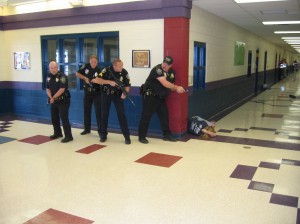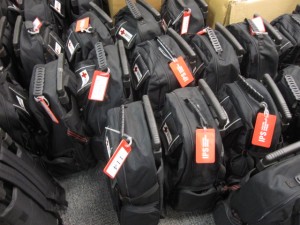
A team of law enforcement officers practicing responses to an active shooter incident in Ashville, North Carolina. While intensive media coverage of mass casualty incidents has heightened our awareness of school violence, the types of horrific events date back to the first mass casualty school attack in America in 1764. As with drunk driving and child molestation, our awareness of problems that have existed for decades has increased more than that actual rate of incidents.
Was school violence an issue in 1979?
1979 was a rough year at Central High School in Macon, Georgia. In the most brutal act of school violence I have ever witnessed, I watched a girl smash a soda bottle against a brick wall and savagely slash another student twice across the chest with the jagged glass during a fight. I will never forget the young girl being strapped to a stretcher drenched in her own blood – at my high school.
Another student was stabbed with a pocketknife and one of our favorite teachers was beaten to the floor of his classroom. His attackers were a group of thugs who entered an unlocked side door armed with pool cues. It seemed so terribly wrong to me that a man who had dropped into Normandy by parachute to defend our nation and came home to serve as an educator could be treated this way.
The school was truly dysfunctional in 1979. Towards the end of the year, I was slashed with a box cutter when a faculty member left my class unattended in a gym. The school principal opted not to call the police because he “didn’t want to hurt the school’s long standing reputation”.
School safety myths
As we demonstrate with careful, research in our book Staying Alive – How to Act Fast and Survive Deadly Encounters, many students and staff have died in mass casualty attacks on K12 schools in the United States long before the Columbine and Sandy Hook massacres. While these terrible attacks were truly catastrophic events, the brutal murder of 95 staff and students by means of an arson fire at the Our Lady of Angels Sacred Hearts School in 1958 was also a horrific and painful event that we should not forget. Dozens of major acts of violence in K12 schools in America go as far back as colonial times with the brutal murder of headmaster Enoch Brown and all but one of his pupils in western Pennsylvania. I am not minimizing modern day mass casualty attacks, but rather attempting to correct a common school safety myth that such attacks are a new phenomenon.
Accurate perspectives result in safer schools
Like tornadoes, school fires, earthquakes, accidents, and medical emergencies, school violence has been with us since the days of the one room school house. Lessons from these tragedies still have much value today. Understanding this can be a life and death matter. Having a balanced, analytical, and logical approach to school safety is the best way to prevent any life-threatening event.
